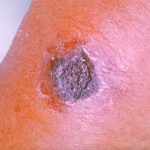 A bacterial disease of cattle and ship that can be transmitted to man though unprocessed wool.
A bacterial disease of cattle and ship that can be transmitted to man though unprocessed wool.
A serious disease caused by Bacillus anthracis, a bacterium that forms spores.
An infectious disease in sheep and cattle that can be communicable to humans.
A disease of cattle and sheep which can be transmitted to humans.
Infectious disease of domestic herbivores (especially sheep) transmissible to man with resultant septicaemia. Causative organism is Bacillus anthracis.
Bacterial (Bacillus anthracis) disease of cattle and other farm animals that can be transmitted to hu¬ mans from infected animals and animal products. The disease causes skin lesions, fever, muscle pain, nausea, and internal hemorrhage; in a serious, often fatal form, it also attacks the lungs. Treatment is by penicillin or tetracycline.
An infectious disease of animals that occasionally infects people. Anthrax is found in goats, cattle, sheep, horses, and exotic wildlife such as hippos, elephants, and the Cape buffalo. The disease is unusual in humans and generally occurs in developing countries in which exposure to infected animals and their products is not adequately prevented.
An acute infectious disease of farm animals caused by the bacterium Bacillus anthracis, which can be transmitted to man by contact with animal hair, hides, or excrement. In man the disease attacks either the lungs, causing pneumonia (wool-sorter’s disease), or the skin, producing severe ulceration (known as malignant pustule). Untreated anthrax can be fatal but administration of large doses of penicillin or tetracycline is usually effective.
A serious disease occurring in sheep and cattle, and in those who tend them or handle the bones, skins and fleeces — even long after removal of the latter from the animals. It is sometimes referred to as malignant pustule, wool-sorters’ disease, splenic fever of animals, or murrain. It is now a rare condition in the United Kingdom. The cause is a bacillus (B. anthracis) which grows in long chains and produces spores which retain their life for years, in dried skins and fleeces; they are not destroyed by boiling, freezing, 5 per cent carbolic lotion, or, like many bacilli, by the gastric juice. The disease is communicated from a diseased animal to a crack in the skin (e.g. of a farmer or butcher), or from contact with contaminated skins or fleeces. Nowadays skins are handled wet, but if they are allowed to dry so that dust laden with spores is inhaled by the workers, serious pneumonia may result. A few countries are believed to have developed anthrax as a weapon of war to be delivered by shells or rockets, despite international agreements to ban such weapons.
An acute infectious disease caused by contact with, ingestion of, or inhalation of the spores of Bacillus anthracis, a large, spore-forming bacterial rod. People who work with contaminated textiles or animal products usually contract it from skin contact with animal hair, hides, or waste (the most common form of the disease, accounting for 95% of cases), but the bacilli may cause a fatal pneumonia if they are inhaled.
A pathogenic condition induced by a specific strain of bacteria. This affliction can be transmitted from animals to humans and commonly results in fatality. Manifestations encompass dermal lesions.
Anthrax is a severe bacterial infection primarily found in livestock that can occasionally transmit to humans. The most prevalent form of this infection in humans is cutaneous anthrax, which manifests on the skin. Another form, known as pulmonary anthrax, affects the lungs and has the potential to be fatal.
Anthrax is attributed to the bacterium Bacillus anthracis. This particular bacterium generates spores that can endure in soil and animal products, remaining in a dormant state for extended periods of time. These spores have the ability to reactivate under favorable conditions.
Livestock typically contract anthrax through grazing on land contaminated with the bacterium. In humans, infection can transpire through contact with materials from infected animals, such as scratches or sores. Additionally, pulmonary anthrax can develop when spores present in infected animal fibers are inhaled.
In the case of cutaneous anthrax, an elevated and itchy area develops at the point of spore entry. This area progresses to form a sizable blister, eventually transforming into a black scab while causing swelling of the surrounding tissues. During the early stages, cutaneous anthrax can be effectively treated with antibiotic medications. However, without proper treatment, the infection can spread to the lymph nodes and bloodstream, potentially leading to fatality.
Pulmonary anthrax inflicts a grave burden upon respiration, leading to formidable breathing challenges and carrying the potential for fatality despite the administration of rigorous medical interventions.
An acute and contagious disease that affects cattle and sheep and can be transmitted to humans. It is caused by the anthrax bacterium and presents in three clinical forms, each named based on the location of the lesion. When it occurs on the skin, it’s referred to as a malignant pustule; if it attacks the lungs, it’s called pulmonary anthrax, and when it affects the intestines, it’s termed intestinal anthrax. This disease is commonly found in individuals who work with animals or animal-derived products and is also known as quarter evil, ragpicker’s disease, tanner’s disease, and woolsorter’s disease.